
Windham County is one of the eight historical counties in the U.S. state of Connecticut, located in its northeastern corner. As of the 2020 census, the population was 116,418, making it the least populous county in Connecticut. It forms the core of the region known as the Quiet Corner. Windham County is included in the Worcester, MA-CT Metropolitan Statistical Area, which is also included in the Boston-Worcester-Providence, MA-RI-NH-CT Combined Statistical Area. The entire county is within the Quinebaug and Shetucket Rivers Valley National Heritage Corridor, as designated by the National Park Service.

Willimantic is a census-designated place located in the town of Windham in Windham County, Connecticut, United States. It is a former city and borough, and is currently organized as one of two tax districts within the Town of Windham. Willimantic is part of the Southeastern Connecticut Planning Region. Known as "Thread City" for the American Thread Company's mills along the Willimantic River, it was a center of the textile industry in the 19th century. Originally incorporated as a city in 1893, it entered a period of decline after the Second World War, culminating in the mill's closure and the city's reabsorption into the town of Windham in the 1980s. Heroin use, present since the 1960s, became a major public health problem in the early 2000s, declining somewhat by the 2010s. Though the city was a major rail hub, an Interstate Highway has never passed within ten miles, despite early plans to connect it.

Windham is a town in Cumberland County, Maine, United States. The population was 18,434 at the 2020 census. It includes the villages of South Windham and North Windham. It is part of the Portland–South Portland–Biddeford, Maine Metropolitan Statistical Area.
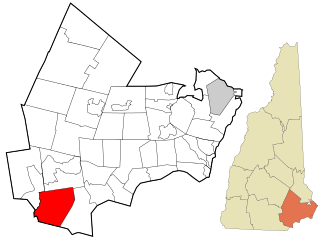
Windham is a suburban town in Rockingham County, New Hampshire, United States. The population at the 2020 census was 15,817, up from 13,592 in 2010.
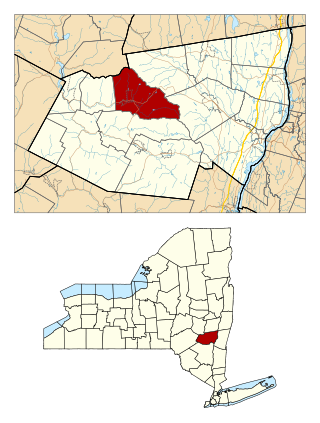
Windham is a town in Greene County, New York, United States. The population was 1,708 at the 2020 census. The town was probably named for the town or county of Windham, Connecticut, as many of its earliest settlers came from that state as well as other parts of New England. The town has two nicknames: "Land in the Sky" and "Gem of the Catskills".

Brattleboro, originally Brattleborough, is a town in Windham County, Vermont, United States, located about 10 miles (16 km) north of the Massachusetts state line at the confluence of Vermont's West River and the Connecticut. With a 2022 Census population of 12,106, it is the most populous municipality abutting Vermont's eastern border with New Hampshire, which is the Connecticut River.

Barry Clinton Windham is an American retired professional wrestler. The son of wrestler Blackjack Mulligan, he is best known for his appearances with the National Wrestling Alliance (NWA) and World Championship Wrestling (WCW).
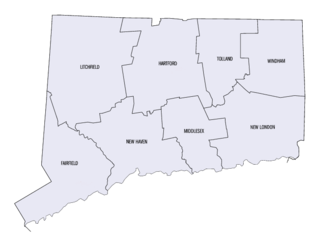
This is a list of properties and districts listed on the National Register of Historic Places in Connecticut. There are more than 1,500 listed sites in Connecticut. All 8 counties in Connecticut have listings on the National Register.

The Presumpscot River is a 25.8-mile-long (41.5 km) river located in Cumberland County, Maine, United States. It is the main outlet of Sebago Lake. The river provided an early transportation corridor with reliable water power for industrial development of the city of Westbrook and the village of South Windham.
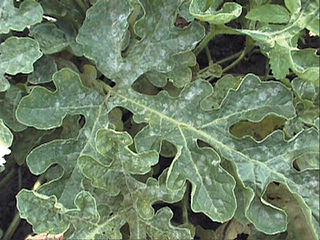
Podosphaera fuliginea is a plant pathogen that causes powdery mildew on cucurbits. Podosphaera fuliginea and Erysiphe cichoracearum are the two most commonly recorded fungi causing cucurbit powdery mildew. In the past, Erysiphe cichoracearum was considered to be the primary causal organism throughout most of the world. Today, Podosphaera fuliginea is more commonly reported.
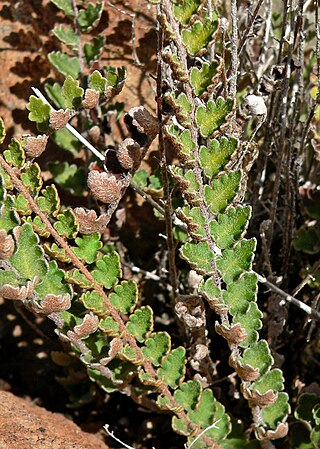
Astrolepis is a small genus of ferns in the family Pteridaceae. It was formed in 1992 from species previously placed in Cheilanthes and Notholaena. The name is derived from the Greek words ἄστρον, meaning "star," and λεπίς, meaning "scale," referring to the star-like scales on adaxial blade surfaces. Members of the genus are commonly known as star-scaled cloak ferns and are native to the Americas.
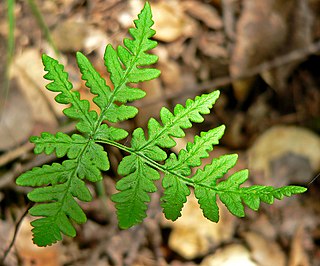
Pentagramma is a small genus of North American ferns. Until 1990 members of this genus were included in Pityrogramma, and there has been considerable disagreement regarding the species' taxonomy. In the most recent treatment, six diploid species are recognized.

The John M. Wynne Unit (WY) is a men's prison of the Texas Department of Criminal Justice, located in northern Huntsville, Texas, at the intersection of Farm to Market Road 2821 West and Texas State Highway 75 North. The Windham School District has its headquarters in the unit. Wynne, the second oldest prison in Texas, was named after John Magruder Wynne, who served as a prison employee and later as a board member of the prison system from 1878 to 1881. The unit, on a 1,412 acres (571 ha) plot of land, is co-located with the Holliday Unit.

The Natchaug River is a 17.9-mile-long (28.8 km) river in Windham and Tolland Counties in northeastern Connecticut. The name Natchaug comes from the Nipmuc language and is believed to mean land between rivers.
Oriental Powder Company was a gunpowder manufacturer with mills located on the Presumpscot River in Gorham and Windham, Maine. The company was one of the four largest suppliers to Union forces through the American Civil War.

Windham Hill Records was an independent record label that specialized in instrumental acoustic music. It was founded by guitarist William Ackerman and Anne Robinson in 1976 and was popular in the 1980s and 1990s.

Gaga is a genus of 19 species of ferns in the family Pteridaceae named after American singer and songwriter Lady Gaga. Two of the 19 species are newly-described: Gaga germanotta from Costa Rica, named after the family of the singer, and Gaga monstraparva, in honor of Gaga's fans, whom she calls "little monsters". According to biologists, the ferns bear a close resemblance to Gaga's costume from the 52nd Annual Grammy Awards and also bear a distinct DNA sequence spelling GAGA.

Batavia Kill is a 21-mile-long (34 km) tributary of Schoharie Creek, that flows across the towns of Windham, Ashland and Prattsville in the U.S. state of New York. Its waters reach the Hudson River via Schoharie Creek and the Mohawk River. Since it drains into the Schoharie upstream of Schoharie Reservoir, it is part of the New York City water supply system. From the source to Maplecrest, Batavia Kill drains the northern slopes of the Blackhead Mountains, which include Thomas Cole Mountain, Black Dome, and Blackhead Mountain, the fourth-, third-, and fifth-highest peaks in the Catskills, respectively.

Argyrochosma dealbata, the powdery false cloak fern, is a small fern endemic to the central and southern United States. It grows on calcareous rocks, such as limestone. Its leaves are highly divided, with leaf segments joined by shiny, chestnut-brown axes, and their undersides are coated with white powder, giving the fern its name. First described as a species in 1814, it was transferred to the new genus Argyrochosma in 1987, recognizing their distinctness from the "cloak ferns".

Argyrochosma limitanea, the southwestern false cloak fern, is a species of fern native to the southwestern United States and Sonora, Mexico. It grows on calcareous rocks, and has small, finely-divided leaves with a leathery texture, dark axes connecting the leaf segments, and a heavy coating of white powder on the undersurface. It reproduces apogamously; two subspecies are recognized, which may have originated independently through the hybridization of other taxa not yet discovered. First described as a species in 1919, it was transferred to the new genus Argyrochosma in 1987, recognizing their distinctness from the "cloak ferns".



















